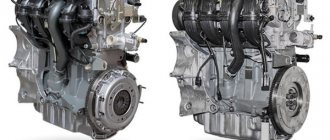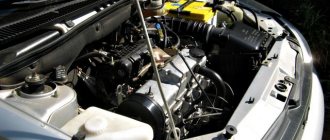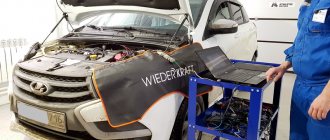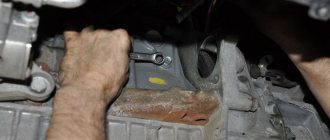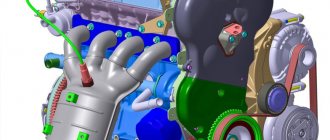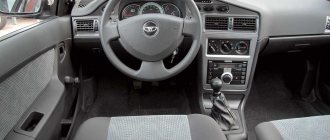Let's compare technical characteristics
If we compare the technical characteristics of these two engines, then in terms of choice, the advantage will be on the side of the 1.8 liter engine (model 21179): 122 horsepower versus 106 for the 1.6 liter (model 21129), acceleration to 100 km/h in 12.1 s (for the “rival” "for 12.8), the maximum speed that a car can develop is 188 km/h for a 1.8-liter engine, 178 for a 1.6-liter engine. Thus, if you are more interested in quality characteristics, then you should definitely pay attention to the first option engine. However, on the other hand, it turned out to be less practical in terms of savings.
What kind of oil is recommended for Lada Vesta?
Regarding savings, the manufacturer recommends filling in SAE 5W30 or SAE 5W40 oil of domestic brands:
The plant calls foreign manufacturers an alternative oil for Vesta with the characteristic 5w30:
- Mobil (5w40 is also allowed, and for new cars 0w40);
- Motul Specific DEXO s2;
- Shell HELIX HX8.
It is precisely with its lower power and volume that the 1.6-liter engine turned out to be a more economical option, because its fuel consumption is slightly lower than that of its opponent: 9.3 liters - in the city; 5.5 – on the highway; 6.9 – in mixed mode (versus 10.2/6.5/7.5 for the 1.8-liter, respectively).
Now let’s move on from dry and boring numbers to a more lively “interior”. As for the drive, there are as many as three options: the larger engine has a timing belt from the German company INA (and as you know, there is no doubt about the quality of German products), the standard 1.6-liter power unit has a regular timing belt, but There is also a similar engine from the Nissan concern H4M (with a power of 110 hp, many sources indicate 114 hp, but this is incorrect), on which a chain is already installed.
In the latter case, we can talk about the “golden mean” between quality and efficiency. Although, in the case of the practicality of the drive, the Nissan engine “jumped ahead” of both of its brothers - here you can save on consumables (the chain is, however, more expensive, but it lasts much longer, there is no possibility of bending the valves).
Perspective
It should be noted that the power unit from the Nissan concern is superior to our domestic engines both in many quality and technical characteristics and in terms of efficiency (more reliable, more durable and uses less oil). Surely, not everyone needs exactly record numbers from a car and its engine - most car owners are looking for the most advantageous combination of reliability, practicality and efficiency, and therefore in this case it is worth paying attention to the Lada Vesta with a Nissan engine.
But there is one thing, the installation of the imported H4M engine has been postponed indefinitely, apparently due to the rise in price of the model and, as a consequence, the recoupment of such an upgrade is not profitable.
There is good news, on October 20, 2022, information was received that AvtoVAZ is testing another engine on the Lada Vesta, this is a 1.4-liter gasoline turbo engine from Renault and 150 hp, we’ll find out how this will end a little later.
But in order not to further mislead the public, it is necessary to mention in a few words the combination of these engines with various types of transmissions. So, the 1.8-liter engine is installed on all three types of gearboxes used in Vesta: robotic, mechanical and automatic. A conventional domestic 1.6-liter power unit is combined with a robot and mechanics. The Nissan engine is also installed on all three types of gearboxes. As most car owners understand, a car cannot develop its full engine potential with a robotic gearbox. But the choice of gearbox remains beyond the scope of this article; among the engines, it is worth noting the 1.6-liter Nissan concern due to its higher reliability and efficiency.
Dimensions Lada Vesta
It was not for nothing that Bo Inge Andersson said that in terms of size, the Lada Vesta will be one of the leaders in the class, which will largely ensure its popularity. That’s right, strictly speaking, the car is difficult to unambiguously classify as segment B, since it is at the junction of classes B and C. The length of the sedan is 4,440 mm, with a width of 1,764 mm and a height of 1,497 mm, and this is noticeably longer than the Hyundai Solaris (4,375 mm, 1,700 mm and 1,470 mm), which is one of the main competitors of the Russian car.
The wheelbase of the Lada Vesta is 2,570 mm, and the track of the front and rear wheels is slightly different - 1,495 mm and 1,502 mm, respectively. The ground clearance of the new product is traditionally higher than that of foreign cars and is equal to 171 mm under the crankcase of the power unit, provided it is fully loaded, and also 144 mm, subject to change under the engine mudguard. This, together with a front overhang of 860 mm and a rear overhang of 915 mm, as well as approach and departure angles of 16.6° and 14.2°, provides the ability to confidently drive on country roads, which is important for residents of small towns.
The luggage compartment of 480 liters of usable volume is also one of the most spacious in the class, and the payload of 487 kg allows you to take a lot of luggage “on board”. Vesta's curb and gross weights are 1,178 kg and 1,653 kg, respectively. But the distribution of curb and total weight along the axles is different. In the first case it is 60/40, and in the second – 52/48. Regarding towing a trailer, the permissible weight for a device equipped with brake mechanisms is 900 kg, and for one without brakes - only 450 kg.
| Specifications | Meaning |
| 2180 | |
| MCP | |
| Overall dimensions, mi: - length - width - height (at curb weight) | 441017641497 |
| Vehicle base, mm | 2635 |
| Front track, mm | 1500 |
| Rear track, mm | 1500 |
| Front overhang, mm | 860 |
| Rear overhang, mm | 915 |
| Approach/departure angle (at full load), degrees. | 16.6/14.2 |
| Ground clearance (at full load), under the engine crankcase, mm | 171 |
| Minimum ground clearance (clearance), at full load, under the engine mudguard, mm | 144 |
| Luggage compartment volume, dm1 | 480 |
| Curb weight (without driver), kg | 1178 |
| Distribution of curb weight on front/rear axles, % | 60/40 |
| Payload, kg | 475 |
| Gross (permitted maximum) weight*, kg | 1653 |
| Distribution of total weight on front/rear axles, % | 52/48 |
| Trailer weight with/without brakes, kg | 900/450 |
| Maximum speed, km/h |
Engine Specifications 21179
We invite you to take a closer look at this engine. Below we describe all the main parameters that the 1.8 engine on the Lada Vesta Cross has.
- index - 21179;
- working volume - 1.8 l;
- engine power - 122 hp, which is achieved at 6050 rpm;
- torque - 170 Nm, at 3750 rpm;
- environmental class - Euro5;
- fuel type - AI92 or AI95;
- average fuel consumption per 100 km;
- Manual Transmission;
- urban cycle - 10.7 l;
- suburban - 6.4 l;
- mixed cycle - 7.9 l;
- automatic transmission;
- urban cycle - 10.1 l;
- suburban - 6.3 l;
- mixed cycle - 7.7l.
The maximum engine life, according to the passport data, is about 200 thousand kilometers.
Information about another internal combustion engine - VAZ-21179
This power unit is the first of its kind for the Lada Vesta. Previously, AvtoVAZ did not use a 1.8 engine. There is a high probability that this particular power unit will be placed inside the long-awaited Cross station wagon, as well as in the sports version of the Lada Vesta, if only it goes into mass production.
This Lada Vesta engine is equipped with a five-speed automatic transmission. Its assembly is carried out using a selective method, and it itself has specific stages of gas distribution in dynamics. The fact of modernity and complete ease of operation determines that the Lux version is rationally equipped with 21179. This unit is the most powerful in the line, as evidenced by the technical characteristics of the engine:
- Power and volume are 122 hp. and 1.8 liters.
- In terms of toxicity, it belongs to Euro-5, 95-grade gasoline is recommended.
- Maximum torque is 170 Nm.
- Capable of operating 300 thousand km without failures or breakdowns.
New engine for VAZ-21179
On a note!
It is quite natural that a higher power level and larger volume increase fuel consumption when compared with earlier ICE models. However, some Lada Vesta car owners value fast acceleration and a sharp start in their cars, so they ignore the extra fuel consumption.
Engine disadvantages
The engine entered mass production and installation with the launch of the new Lada Vesta. Enough time has passed since then, during which car owners and experts have identified a number of the most common breakdowns. These include:
- beating of hydraulic compensators. This problem is not new for AvtoVAZ. Quite often, 16-valve engines produced by a domestic manufacturer suffer from this “sore”. It appears as a result of the use of unsuitable oil or insufficient volume of oil directly in the engine.
- increased oil consumption. Another problem that migrated to VAZ engines, migrated to the new engine with index 21179. As a rule, it can be solved only after replacing the connecting rod and piston group. It’s good if the car is still under warranty and the dealer will perform the procedure for free. If the warranty period has expired, the financial burden of replacement falls on the owner.
As for the rest of the engine’s operation, the overwhelming majority of owners have no complaints about it. The engine has proven itself on the positive side. Timely and correct maintenance is enough and you will not recognize problems with the engine for 150-200 thousand kilometers.
By the way, if you are afraid to take a Vesta Cross with an automatic transmission, then your fears are completely unfounded. As practice shows, the service life of such a box is quite comparable to the mechanical version.
Which motor oil to choose?
In order not to make a mistake when choosing engine oil for Vesta SW Cross, as is the case with other cars, you need to clearly understand the conditions under which the car will operate. First of all, you need to choose the appropriate viscosity of the engine oil. The operating instructions say that the following types of oils are suitable for this engine:
And this is where the nuances mentioned above begin. So, for example, if the car is operated in colder regions, it is better to give preference to liquid oils: 5W-30 or 5W-40. And if the engine is new and has low mileage, it is allowed to use oil with 0W-40 ratings.
If you live in a warm region or use your car exclusively in the spring and summer, you can safely fill in 10W-40 and 15W-40 oils.
Next, you need to select the optimal quality class. Again, according to the operating instructions, it is recommended to use oils of at least SM class according to API or GF-4 according to ILSAC.
State of the valves when the timing belt breaks
Like any modern engine, the Lada Vesta SV Cross engine with a displacement of 1.8 and index 21179 is susceptible to this defect. Indeed, when the timing belt breaks, the valves in the engine become deformed. This happens mainly due to the fact that manufacturers strive to achieve greater power with the same engine size. To make this possible, it is necessary to lighten the connecting rod and piston group while simultaneously increasing the compression ratio.
With this approach, it becomes impossible to groove the pistons in order to exclude the possibility of them “meeting” the valves in the event of a direct belt break. Regardless of the nature of the breakdown, this means a broken timing belt, jamming of the pump and tension roller, you will be faced with a major overhaul.
Fortune lottery
Any Vesta, regardless of its cross-country ability and body type, handles great. When it works.
Alas, as we have noted more than once, the quality is still poor. Even if there were not seven, but one hundred and seven Vests at the test site, we still would not be able to say with complete confidence whether the sedan handles better than the station wagon - and whether the elevated Cross is more exciting. Although the VAZ team, with the advent of Vesta, began to be more jealous of the stability of quality and quickly respond to criticism, the purchase still remains a lottery, aggravated by the fact that, for example, in Moscow, almost no dealer will let you ride in the cars that they have in availability.
Vesta's chassis is excellent: in serviceable cars, the top speed on the elk test is impressive (83-84 km/h), regardless of body type
Of our Wests, only three had a fully serviceable chassis, and the main thing here was to be lucky with the rack and electric booster! Then the steering wheel will delight you with its excellent reactive action. The most unpleasant thing is that no one will replace a faulty electric booster or a “pinched” rack, which usually manifest themselves by “biting” the steering wheel, under warranty: dealers will consider them absolutely in good working order. It is not uncommon for the wheel alignment angles to be carelessly adjusted, which is why Vesta can turn, for example, to the right more readily than to the left, lose stability in a straight line, or even become prone to skidding. It happens that everything happens at once. Fortunately, these ailments can still be treated with proper adjustment.
Due to the fact that Vesta willingly splashes water from under the wheels onto the windshield and into the engine compartment, it is better to avoid speeding through deep puddles. Owners of cars with AMT should be especially careful: moisture gets into the poorly protected sensor connectors on the box - and the electronics may generate an error
| Prices and configurations of Lada Vesta (sedan) cars | ||||
| Equipment | 1.6 MT | 1.6 AMT | 1.8 MT | 1.8 AMT |
| Classic | 584900 | — | — | — |
| Classic Start | 609900 | 634900 | — | — |
| Comfort | 637900 | 662900 | 672900 | 697900 |
| Comfort Image | 660900 | — | 695900 | 720900 |
| Comfort Multimedia | 665900 | 690900 | — | — |
| Luxe | 700900 | 725900 | 735900 | — |
| Luxe Multimedia | 728900 | 753900 | 763900 | 788900 |
| Luxe Prestige | 746900 | — | 781900 | 806900 |
| Exclusive | — | — | 814400 | 839400 |
Engine assembly materials 1.8 Lada Vesta SV Cross
Let's continue our analysis of the engine. Next, we suggest you take a more in-depth look at the parts from which this motor is assembled. Parts List:
- The timing belts used in these engines are manufactured by Continental. The declared belt resource is 180 thousand km. How truthful this can only be learned from the owners of Vesta Cross SV or from our own experience;
- Continental also supplies injectors. This model of nozzles has a longer life and increased performance;
- valves from Mahle;
- pump from GMB. Its resource corresponds to the timing belt and is the same 180 thousand km;
- an oil pump from GMB is also used;
- but the installed camshafts were manufactured by Toyota Tsusho. They compare favorably with the old ones in weight;
- INA phase adjustment mechanism.
Distinctive features of the engine
Many car enthusiasts rightly note the external similarity of the 21179 engine with early examples of 16-valve VAZ engines and, in particular, with the 1.6 engine. However, it was possible to achieve a larger engine volume compared to 1.6 not by increasing the diameter of the cylinders, but by increasing the piston stroke in the previous cylinder. To realize the idea, it was necessary to remake the connecting rod and piston group and install a new crankshaft.
It is worth noting that the new engine uses variable valve timing, which was not present on any previously released version.
The oil and cooling passages have also changed significantly.
New injectors with increased performance, mentioned above, were needed due to an increase in engine displacement. In addition to them, it was necessary to install a new throttle valve and increase the volume of the oil pan to 4.4 liters. An increase in the volume of oil in the engine entailed the installation of a more efficient pump. The intake ports have also become larger.
It is worth mentioning a new method for reading mass fuel consumption. An absolute pressure sensor and an air temperature sensor are now responsible for this.
Features of the VAZ-21129 power unit
The internal combustion engine works with both a manual transmission and an automatic transmission. Engines 21129 were transformed from a weaker version of the VAZ-21127, which did not meet Euro-5 standards. This transition turned out to be very useful for the overall automotive industry of the country. The following reformation of the engine design should have been made:
- The new product, unlike 21127, has a reduced compression ratio. From now on, it is possible to fill with fuel with a lower octane number.
- The exhaust and resonant intake systems have been completely redesigned.
- The electronic engine control system (ECM) has received completely new firmware.
- The engine suspension was significantly adjusted.
The Lada Vesta engine with index 21129 looks very modern in appearance. It contains air pressure and temperature sensors. The 21129 engine is installed, mainly in the “Comfort” sedan trim levels. A tuning version with up to 150 “horses” can also be installed on more expensive sports models. It was possible to improve the characteristics compared to the previous version with the following manipulations:
- Engineers have reduced friction losses by reducing the thickness of oil scraper and compression rings.
- The designers completely redesigned the exhaust and intake resonator.
- The pistons on this engine model have become lighter and are made of aluminum. This makes it more likely that the valves will not bend if the timing belt breaks.
On a note!
It has been experimentally proven that when operating, the VAZ-21129 consumes three ml of oil per liter of gasoline. Official documentation confirms that a quarter liter of oil fluid will be required per thousand kilometers. In comparison: Nissan engines operate twice as much.
Motor Lada Vesta with index 21129 The parameters of the internal combustion engine itself are given below:
- VAZ-21129 has a power of 106 hp. With.
- The engine capacity is 1.6 liters.
- The maximum torque is 148 Nm.
- According to the passport, an oil change should occur every 15 thousand km.
- It is possible to increase the engine power by tuning the engine, up to 150 hp. With.
- A specific damper system rationally controls the dimensions of the intake manifold, which allows the internal combustion engine to operate without failure at any speed.
- Compression level – 12.5.
- Engine performance is determined at 200,000 km.
Speed characteristics of Lada Vesta Cross engines of 1.8 and 1.6 liters.
Engine performance readings clearly demonstrate the final performance. We note the high-quality settings of the manufacturer. The maximum torque of 170 Nm can be achieved at 4000 rpm. At the same time, at 5500 rpm, the engine produces its maximum 122 hp. With.
Video about maintenance and repair of the Lada Vesta Cross engine:
When choosing a car, you need to decide not only on the brand, color, appearance, but also the technical parameters of the car. Whether or not to operate a more powerful engine is preferable, only the driver can decide, because everyone has their own preferences. If the choice falls on the Russian Lada Vesta Cross, you will need to choose between 1.6 liter or 1.8 liter engines.
Lada Vesta which engine is better, what to choose 1.6 or 1.8
Wheel discs must not have deformations, cracks or other damage.
The tires installed on the vehicle must match the vehicle model in size and load capacity. Tears and swelling of the sidewalls are not allowed. Tires should not have through damage or delamination and signs of uneven tread wear.
Acceptable degree of tire wear: The remaining tread depth must be at least 1.6 mm.
When installing tires with a directional road tread pattern, which can be identified by the arrow on the sidewalls, it is necessary to check that the arrows coincide with the direction of rotation of the wheels.
Periodically check the air pressure in your tires with a pressure gauge. Operating tires with pressures different from those recommended (see Table 1) leads to their premature wear, as well as to deterioration of vehicle stability and controllability. If there is a constant drop in tire pressure, check for air leaks through the valve spool. If there is an air leak, tighten the spool, and if this does not help, replace it with a new one.
If the pressure drops even though the spool is working, the tire needs to be repaired.
To avoid damage to the sealing layer of the tire, dismantle and install it using a special device or have it done by dealers. In order not to disturb the balancing of the wheel, before beading, make a chalk mark on the tire opposite the valve, and during installation, install the tire along this mark.
After installing new tires, be sure to have the wheels balanced by your dealer.
To ensure even tire wear, rotate the wheels as shown in Figure 1.
When operating your vehicle, avoid rubbing wheels against road curbs and driving fast on roads with damaged surfaces (potholes, potholes, etc.), as damage to the wheel rim can cause not only its imbalance, but also loss of tightness of tubeless tires. If vibrations occur while driving, have your wheels balanced by your dealer. When the vehicle is equipped with wheels measuring 16 and 17 inches, the spare wheel measuring 15 inches (185/65 R15 88H) is a wheel for temporary use. Before installing it, turn the ignition switch to the “STOP” position for at least 5 minutes. Start moving smoothly without slipping. The vehicle must be driven with care when the temporary use tire is installed; the maximum speed limit is indicated on the temporary use spare tire placard. You should have your tire repaired as soon as possible or buy a new tire of the same brand, size, type, and tread pattern as your other tires. It is prohibited to operate a vehicle with more than one spare tire installed on it for temporary use. It is allowed to use winter tires (MS) of the above dimensions and index Q with a corresponding limitation of the maximum vehicle speed (up to 160 km/h).
Rice. 1. Wheel rearrangement diagram
Table 1
| Vehicle modification and execution | Tire size with load capacity and speed indexes12 | Technical data of the wheels used | |||||
| DIA,3 mm | PCD,4 mm | Number of mounting holes, pcs. | Rim width (inches) | Rim offset (ET)5, mm | Air pressure in tires, front/rear, MPa (kgf/cm2) | ||
| Installed by the manufacturer (standard) | |||||||
| "SE and SW" | 185/65R15 88H | 60,1 | 100 | 4 | 6J | 50 | 0,22/0,22 (2,2/2,2) |
| 195/55R16 91H | |||||||
| "SW Cross" | 205/50R17 89V | 61/2J | 43 | ||||
| 205/50R17 93W | |||||||
| Allowed to be installed during operation | |||||||
| "SE and SW" | 185/65R15 88H, T | 60,1 | 100 | 4 | 5J, 51/2J, 6J, 61/2J | 50 | 0,22/0,22 (2,2/2,2) |
| 195/55R16 87, 91T, N | 51/2J, 6J, 61/2J | ||||||
| "SW Cross" | 205/50R17 89H, V | 43 | |||||
| 205/50R17 93W | |||||||
1 – It is allowed to use winter tires of the above dimensions and index Q with a corresponding limitation of the maximum vehicle speed (up to 160 km/h). 2 – Speed indices: T – up to 190 km/h, H – up to 210 km/h, V – up to 240 km/h, W – up to 270 km/h. Load capacity indices: 87–545 kg, 88–560 kg, 89–580 kg, 91–615 kg, 93–650 kg.3 – DIA – diameter of the central hole of the wheel.4 – PCD – diameter of the wheel mounting holes.5 – Reach rim (ET) - the distance from the mating plane of the disk to the middle of the rim.
Permissible sizes of tires, wheels and air pressure in tires
Note. To maintain the original level of stability, controllability, vibration-acoustic performance, and fuel consumption, install on your car tires and wheels only of the same size (tires preferably the same model) that were installed on the new car.
Wheel fastening (wheel bolts)
table 2
| Number of bolts, pcs. | Bolt thread | Length of the cylindrical part of the bolt, mm | Hexagon size of the wrench head, mm | Bolt strength class, not less | Bolt tightening torque, N*m |
| 4 | M12×1.5 | 24,5 0,5 | 17 | 9,8 | 105±15 % |
Tire Pressure Monitoring System TPMS
The vehicle is optionally equipped with a tire pressure monitoring system (TPMS).
Operating principle: each wheel (except the spare) has a sensor built into the valve, which regularly measures the tire pressure while driving. When the system detects insufficient air pressure in the tires (flat tire, puncture, etc.), the warning light comes on. Continuing to drive with low tire pressure can lead to overheating and mechanical failure. It is necessary, observing precautions, to stop the car, check the condition of the tires and bring the pressure level in them to normal. The tire should be inflated with the ignition on at the recommended pressure, after which the warning light should turn off.
When you turn on the ignition, the warning light, regardless of the tire pressure status, turns on in test mode for a few seconds, then goes off.
If a system malfunction is detected (loss of communication with the wheel sensor, failure of the receiver, etc.), the indicator flashes for about a minute, then remains on. Please note that using a TPMS system does not mean that you do not need to properly maintain your tires or maintain proper tire pressure.
The spare wheel is not equipped with a tire pressure reduction sensor and when used, the warning light will turn on. You should move with caution until the problem is eliminated.
Note. To change tires and find out about additional equipment compatible with the system, as well as its availability, contact your LADA dealer. The use of any other equipment may interfere with the operation of the system.
Tire pressure monitoring
Tire pressure should be checked:
• after rearranging the wheels;
• after replacing a wheel;
• in a variant when changing the reference value of the TPMS tire pressure monitoring system (see subsection “On-board computer”)
ATTENTION!
Never deflate hot tires to return pressure to normal.
Video
Comparison of technical characteristics of 1.6 and 1.8
To decide on the choice of engine for Lada Vesta Cross 1.6 or 1.8, you need to compare the characteristics of each model. As for power, the 21179 will have more and is 122 horsepower compared to 106 in the 21129 engine. The power system is electronically controlled fuel injection in two models. Both engines have in-line cylinders and require the same fuel (min AI 92).
Main technical characteristics of Lada Vesta
The LADA Izhevsk enterprise currently produces only the LADA Vesta sedan, but in the future AVTOVAZ intends to launch the production of station wagons, crossovers and several sports modifications based on this model.
The car was created on its own “B” platform, which they plan to use in the future for the production of both domestic cars and models under the Renault-Nissan Alliance brands. Many components on the new product are of foreign origin and borrowed from other models, but gradually production is moving more and more to domestic components, which allows reducing production costs.
Table of Lada Vesta characteristics (TTX)
| 1.6 l 16 cl. (106 hp), 5AMT | 1.6 l 16 cl. (106 hp), 5MT | |
| Body | ||
| Wheel formula / drive wheels | 4 x 2 / front | 4 x 2 / front |
| Engine location | anterior transverse | anterior transverse |
| Body type / number of doors | sedan / 4 | sedan / 4 |
| Number of seats | 5 | 5 |
| Length / width / height, mm | 4410 / 1764 / 1497 | 4410 / 1764 / 1497 |
| Base, mm | 2635 | 2635 |
| Front/rear wheel track, mm | 1510 / 1510 | 1510 / 1510 |
| Ground clearance, mm | 178 | 178 |
| Luggage compartment volume, l | 480 | 480 |
| Engine | ||
| Engine code | 21129 | 21129 |
| engine's type | petrol | petrol |
| Supply system | electronically controlled fuel injection | electronically controlled fuel injection |
| Number, arrangement of cylinders | 4, in-line | 4, in-line |
| Working volume, cubic meters cm | 1596 | 1596 |
| Maximum power, kW (hp) / rev. min. | 78 (106) / 5800 | 78 (106) / 5800 |
| Maximum torque, Nm/rev. | 148 / 4200 | 48 / 4200 |
| Fuel | gasoline, min 92 | gasoline, min 92 |
| Dynamic characteristics | ||
| Maximum speed, km/h | 178 | 175 |
| Acceleration time 0-100 km/h, s | 14,1 | 11,2 |
| Fuel consumption | ||
| Urban cycle, l/100 km | 9,0 | 9,3 |
| Extra-urban cycle, l/100 km | 5,3 | 5,5 |
| Combined cycle, l/100 km | 6,6 | 6,9 |
| Weight | ||
| Curb weight, kg | 1230…1280 | 1230…1280 |
| Technically permissible maximum weight, kg | 1670 | 1670 |
| Maximum trailer weight without brake system / with brake system, kg | 450 / 900 | 450 / 900 |
| Fuel tank volume, l | 55 | 55 |
| Transmission | ||
| Transmission type | 5AMT | 5MT |
| Final drive ratio | 3,9 | 3,9 |
| Suspension | ||
| Front | independent, MacPherson type, spring, with anti-roll bar | independent, MacPherson type, spring, with anti-roll bar |
| Rear | semi-independent with linked levers, spring, with gas-filled telescopic shock absorbers | semi-independent with linked levers, spring, with gas-filled telescopic shock absorbers |
| Steering | ||
| Steering gear | rack and pinion | rack and pinion |
| Tires | ||
| Dimension | 185/65 R15 (88, N/T); 195/55 R16 (91, T) | 185/65 R15 (88, N/T); 195/55 R16 (91, T) |
The sedan is designed for 5 passengers, and its technically permissible curb weight is 1,670 kg. Curb weight varies from 1230 to 1280 kg, depending on the configuration. The maximum weight of a towed trailer without a brake system is 450 kg, with a brake system 900 kg.
The fuel tank volume is 55 liters, dual-fuel modifications have additional 2 gas cylinders, which are designed for pressure up to 250 atmospheres. According to the manufacturer itself, fully filled cylinders allow Vesta to travel 1,000 kilometers without refueling.
Comparison of prices and options
Prices for Lada Vesta Cross with 1.6 and 1.8 engines differ insignificantly - 770 thousand and 795 thousand Russian rubles in the “Lux” configuration. Unfortunately, the 21129 engine is available exclusively in this version; if you are interested in richer modifications, you will have to fork out for the 21179 engine.
The equipment for these two cars is absolutely the same. As for safety, there are front and side airbags, child seat mounts, ABS, BAS, EBD, ESC, HAS, crankcase protection, alarm, headlights, door locks. The doors lock automatically and have an anti-theft device.
The interior includes sockets at the front and rear, a case for glasses, an on-board computer, lighting, and a sun visor. The seat upholstery can be chosen in orange or grey. The rear seat reclines.
For driving comfort, the seat belt and steering column, as well as the driver's seat, are adjustable. The interior has an air filter, climate control, and the seats can be heated. Vesta also provides for weather and parking sensors. An audio system is provided.
The exterior includes exterior mirrors, spare tire, R17 alloy wheels, cargo rails and fairings.
Advantages and disadvantages of the 1.6 engine
The 1.6 and 1.8 engines installed on the Lada Vesta SW Cross have their advantages and disadvantages. When choosing a car, you need to pay attention to the characteristics of its power unit, because the quality of the trip and possible financial costs for repairs will depend on its reliability.
Main advantages:
- Complies with European standards;
- Complies with environmental standards;
- The engine contains hydraulic compensators that smooth out the shock load;
- Time-tested design.
Flaws:
- Hydraulic compensators may knock for some time immediately after starting;
- Not the most economical;
- Over time, engine oil may develop.
Pros and cons of the 1.8 engine
This power unit cannot be safely recommended to anyone who has decided to buy a Lada Vesta Cross and has a few extra tens of thousands of rubles, since it is also not ideal, and has not only advantages, but also some significant disadvantages.
Main advantages:
- Power and torque are noticeably greater than those of a smaller engine;
- Smooth ride;
- Confidently pulls a loaded car.
Minuses:
- Uneconomical fuel consumption;
- The difference in acceleration with the 1.6 engine is insignificant;
- Less environmentally friendly;
- Repairs are more expensive;
- Noise during operation.
If you choose a Vesta SV Cross with a 1.6 or 1.8 engine, then first of all you need to test drive cars with both types of power units and understand for yourself whether it’s worth overpaying for additional horsepower or not.
Transmissions
In this regard, AvtoVAZ also offers a wide choice. The main gearbox will be a 5-speed manual, which is also installed on other VAZ models. In 2012, it was modified, some components were replaced, Japanese and German parts were supplied, the volume of oil poured was reduced, and other work was carried out. As a result, the gearbox is quieter, shifts have become more convenient, and vibrations have decreased.
Technical characteristics of Lada Vesta gearboxes.
The Lada Vesta will not receive a classic automatic transmission, which has upset many visitors to dealer showrooms. Its place was taken by a “robot” of the AMT type, due to its low cost of production, created on the basis of a manual gearbox bearing the index 2180. Despite the rougher work (small jerks and jolts when switching), the use of components from the world companies ZF and VALEO, coupled with less appetite and no need to warm up, the robot has a real chance of becoming a worthy alternative to an automatic transmission.
Weight of Lada Vesta engines and gearboxes.
In addition, the Lada Vesta will also receive a CVT, which will be transferred to the domestic sedan from the Japanese model Nissan Tiida. However, there is no more complete information on it yet.
Nominal filling volumes of Lada Vesta (in liters).

